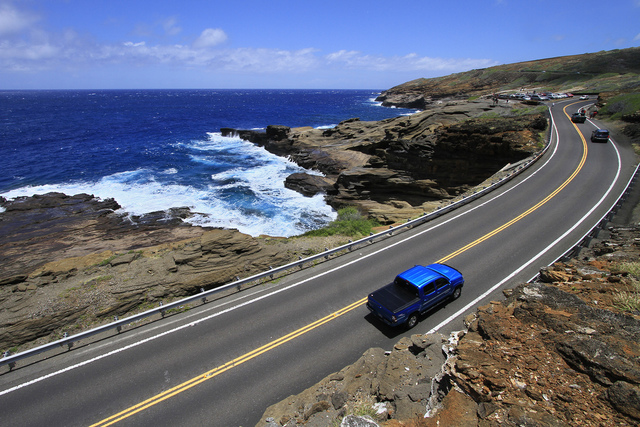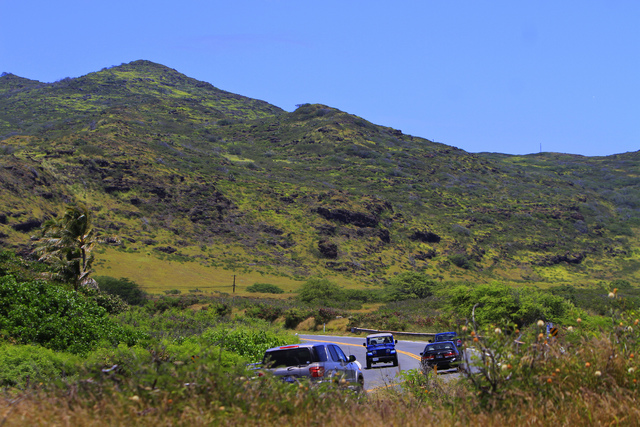Funding delays costly to Ka Iwi Coast preservation effort

DENNIS ODA / MAY 2013
Efforts to protect the land between Sandy Beach and the Makapuu Point Lighthouse have gone on since the 1970s.

DENNIS ODA / 2013
Efforts to protect the land between Sandy Beach and the Makapuu Point Lighthouse have gone on since the 1970s.


A community organization is paying more than it bargained for to protect 181 acres in East Honolulu overlooking the scenic Ka Iwi Coast due to a holdup of financing from the city and state.
The Trust for Public Land bought the property in March from a liquidated development firm for $3.65 million to prevent a competing buyer from acquiring the site once intended for vacation cabin development.
But the nonprofit, which obtained a loan for the purchase, had been counting on city and state land preservation programs that committed to provide $3.5 million for the deal almost two years ago.
So for the last nine months the trust has been stuck making interest payments on the loan — about $7,300 a month — while it waits for what it still hopes will be the city and state contributions.
“We are hopefully at the end of working through this issue,” Laura Kaakua, native lands project manager for the trust, told members of the Hawaii Kai Neighborhood Board last week.
Kaakua said she expects government attorneys are close to putting the delay issues to rest and will release the money to pay off the loan within the next few months.
Don't miss out on what's happening!
Stay in touch with breaking news, as it happens, conveniently in your email inbox. It's FREE!
The state Department of Land and Natural Resources, which pledged $1 million through its Legacy Land Conservation Program, couldn’t say whether it believes a resolution is possible, according to spokesman Dan Dennison.
“DLNR is actively working with all the other parties to resolve the issues, and is prepared to rapidly complete its role in the transaction when consensus is reached,” he said in an email.
Ray Soon, chief of staff for Mayor Kirk Caldwell, said in a statement that the city is confident the issues will be resolved in a timely manner.
“Mayor Caldwell strongly supports the preservation of the Ka Iwi lands and is pleased that the Trust for Public Lands already owns the property, meaning it can never be developed,” he said.
The holdup over the taxpayer money has to do with encumbrances, or restrictions, that prior owners of the property tied to the title of the land.
The restrictions, Kaakua said, specify repercussions for not subdividing or developing the land. But Kaakua said her organization’s research, which was assisted by a historical owner of the property, Kamehameha Schools, concluded that the encumbrances are unenforceable.
“We have done a very thorough review and believe the restrictions have expired,” she said in an interview.
The original plan was for the community nonprofit Livable Hawaii Kai Hui to purchase the property with the city and state funds, and then manage the land for educational public uses and preservation.
Livable Hawaii Kai raised more than $500,000 from the community last year to help with the purchase, which was expected to be more than $4 million based on the seller’s appraisal, which turned out to be high.
A lot of the money raised was spent on closing costs and the $150,000 shortfall between the sale price and what the city and state funds were supposed to cover. Since March, though, money that would have gone to managing the land instead is paying mortgage interest.
The city, according to Soon, made clear to the Trust for Public Land in March that it would withhold its funding until the title issues were resolved.
Kaakua said the two nonprofits couldn’t delay the purchase because a backup buyer was ready to act if the nonprofits didn’t buy the property in March.
“We had to make a decision to take the risk and take out a loan to purchase the property,” she said. “This was a big risk, but it was absolutely worth it.”
Kaakua said efforts by Livable Hawaii Kai and predecessor groups to protect the land known as Ka Iwi Mauka along with nearby shoreline parcels over prior decades convinced the trust’s national board to go ahead with the loan.
The older efforts, dating back to the 1970s, blocked developers from putting up hotels, condominiums and golf courses on oceanfront sites between Sandy Beach and the Makapuu Lighthouse.
The effort to develop Ka Iwi Mauka goes back a least a decade when a firm led by local developer Bob Gerell floated a plan to develop cabins on two parcels zoned for preservation and owned by another development firm, Maunalua Associates.
Gerell’s plan was to develop 180 vacation cabins under county zoning rules that allowed cabins as a secondary use to recreational activities. On-site recreation facilities in the plan include a pool, tennis courts, volleyball courts and mountain biking trails.
Public opposition that included a 3,000-signature petition erupted over the plan, and the city Department of Planning and Permitting rebuffed a permit application after concluding that recreation activities appeared to be an accessory to the vacation cabins instead of the other way around.
Gerell’s firm, QRM LLC, kept trying to obtain a permit and in 2008 offered to reduce its plan and give half the site to a willing organization for free. That same year, QRM bought the land from Maunalua Associates for $3.6 million and resold it for $5.6 million to Kulia I Kanu‘u Estates LLC, an affiliate of Utah-based Management Solutions Inc.
About two years later, Management Solutions was sued by the U.S. Securities and Exchange Commission, and a federal judge in Utah ruled in 2013 that the company improperly mixed investor capital and spending on assets that were largely mainland apartment buildings roughly valued at $220 million.
The federal court appointed a receiver to sell company assets to repay defrauded investors and creditors. Livable Hawaii Kai and the Trust for Public Land arranged the state and city contributions and reached an agreement with the receiver, Gill Miller, to buy the property.
Though the property is now in safe hands, the nonprofits want to move on to caring for the land instead of using the community’s money to service a loan.
“We are almost there,” Kaakua said. “We are almost to the finish line.”
6 responses to “Funding delays costly to Ka Iwi Coast preservation effort”
Leave a Reply
You must be logged in to post a comment.




The path to preservation/conservation is rarely easy.
Very Grateful to the RESIDENTS who made this happen. (we gave $100 since its worth it to SAVE our lands. and wish MORE communites would do this type of conservation and PREVENT over Development !!
As usual the city/state are INCOMPETENT and SLOW to get ANYTHING done in a timely manner.
Get off your okole city lawyers and GET THIS DONE ASAP !!
The city was not at fault here. They were very clear that the encumbrences must be removed first and this organization took a risk. Recorded title interests can not be removed willi-nilli any time it suits a buyer. If I were the back up offer buyer, I would be pretty upset right now….
Let’s take bets: Which project will be finished first, the rail, or this land deal?? I don’t think any of us will live long enough to find out!
This is one of only a few places on Oahu Krookwell will never develop.
Krookwell speaks with a forked tongue. The new developers probably gave generously to Krookwell’s re-election campaign…
Krookwell never saw a parcel of land he didn’t think a 400ft highrise would look better on.